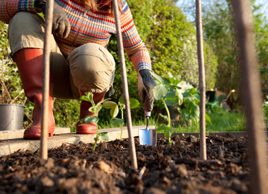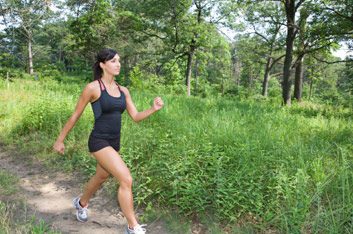
Earth Day is every day
One day a year the world joins together to help care for our environment. But who says every day isn’t Earth Day? Work these five activities into your daily routine, because the planet can never have too much TLC.

1. Volunteer at a community garden
Michelle Obama planted one on the South Lawn of the White House and a new one has sprouted at Vancouver’s City Hall, as well. Fuelled partly by a boom in interest in the health benefits of locally grown food, community gardens are popping up across North America.
“It’s a vitamin D sport,” says Sylvia Holland, a gardener with Vancouver’s Green Streets program, who says she has seen full-body benefits from her gardening, including improved strength and aerobic health. “But community gardening is also about creating a healthy society, a healthy planet.”
Carolyn Bailey, community gardens coordinator with EcoSource, an environmental education charity in Mississauga, Ont., sees that in her Garden of the Valley program. “The garden benefits the Mississauga Valley Park’s ecosystem by bringing more flowering plants into the park, encouraging pollinators like bees,” she says. “But there are less tangible health benefits, too, from the friendships that gardeners make with each other, or as seniors share their knowledge with young families, or new Canadians literally put down roots in their new community.”

2. Trade in your car for a bicycle for the day
More and more women are rediscovering the fun of riding a bike, whether it’s joining a group of friends to ride local trails, taking in a combo spinning/yoga class, or simply zipping around the neighbourhood to do errands or enjoy a family outing. (And, hey, reducing your gasoline budget-and your greenhouse gas emissions-doesn’t hurt, either.)
“Cycling helps you develop fantastic lower body strength: your quadriceps, hamstrings and buttocks,” says Jenny Brown, a fitness trainer and women’s cycling coach at Reactivated in St. Catharines, Ont. “You develop toned muscles without bulk.” You also strengthen core muscles because you’re working on keeping balanced and upright, adds Patti Fletcher. a bike-shop owner and women’s cycling instructor in Comox, B.C.
Cycling is often as good for the spirit as it is for the body. Research published in 2008 in the British Journal of Sports Medicine found that study participants with depressive and anxiety disorders who cycled for 20 minutes reported decreased levels of anxiety, and those who picked the level of intensity they wanted to ride at reported an increase in well-being.

3. Visit your local farmers’ market
Not only is farm-fresh better for you and the environment-on average, food travels more than 2,500 gas-guzzling kilometres to get to your table-but chances are you’ll actually eat more fruits and vegetables if you go local. Researchers from Saint Louis University surveyed more than 1,600 parents who live in rural communities and found that those who often ate produce either grown in their own yards, or bought directly from a farmer or local market, were three times more likely to eat at least five servings of fruits and vegetables a day-and so were their kids. “They also ate a wider variety and were able to say their children had more favourite fruits and vegetables,” says Susie Nanney, a registered dietitian and one of the authors of the study.
Wondering where to start when the market’s stalls are overflowing with summer produce? You can’t go wrong shopping for a rainbow of colours. Begin by thinking about your eyes as you look for produce that’s full of the carotenoids lutein and zeaxanthin, such as red and yellow peppers, spinach, zucchini and romaine lettuce. Studies have found that people who eat the most produce high in these carotenoids are the least likely to develop age-related macular degeneration, a condition that can eventually cause blindness and affects two million Canadians over the age of 50.

4. Swap out your cleaning products for eco-friendly
Most “green” cleaners spurn ingredients that may cause reproductive harm or lead to chronic health problems such as asthma-a disease that disproportionately affects professional cleaners and has been linked to certain chemicals in conventional cleaning products. Furthermore, green cleaners offer natural ingredients instead of synthetic ones (although natural doesn’t necessarily mean safe) and more concentrated formulas. They may also be free of petroleum distillates and phosphates, which can harm aquatic ecosystems, and packaged in recycled or recyclable materials.
The industry is largely unregulated-manufacturers can make vague claims about products, such as “all-natural,” and aren’t required to disclose ingredients. One way to ensure you’re buying green is to select products with the stamp of a third party, such as EcoLogo (started by Environment Canada and run by TerraChoice). EcoLogo uses independent auditors to verify what’s in a product and certifies only those that meet its rigid environmental criteria. The Attitude brand by Bio Spectra has a stamp, and there are several others, including GreenLine, developed for Wal-Mart Canada, and Nature Clean, one of the granddaddies in the industry.

5. Help the environment by connecting with it
Researchers have long touted the physical benefits of walking, such as increased oxygen intake, revved-up circulation, a healthier heart and calorie burning. But walking can also shed stress and enhance calm energy. “Mindful walking means that you’re living in the moment,” says Laura Farres, a Vancouver sport psychology consultant. So instead of pounding the pavement with your head down and earphones in, enjoy active meditation, time to re-energize and think.
“Think about every aspect of your foot movement: lifting the heel, the middle of your foot and then the toes,” says JoAnne Hunter, a nurse practitioner at Toronto Western Hospital who teaches walking meditation, in which participants walk very slowly, inhaling with one step and exhaling with the next. “This helps you think about your connection to the earth,” Hunter says. “You feel peaceful and in touch with your body, which reduces stress.”
Related:
• 5 habits for eco-friendly food shopping
• 10 ways to reduce kitchen waste
• Greening your sex life: 10 eco-friendly ways to make love better
